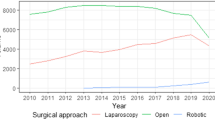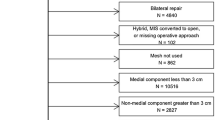Abstract
Purpose
As the ultimate procedure which each surgeon decides to perform for a unilateral uncomplicated inguinal hernia remains controversial, we queried the Americas Hernia Society Quality Collaborative (AHSQC) database to report the collective experience of surgeons in the United States whom contribute to AHSQC to provide a view of the surgical approaches performed.
Methods
The AHSQC data registry was queried for all adult patients who underwent a primary, unilateral, elective, inguinal hernia repair. A retrospective review was conducted to analyze patient demographics, hernia characteristics, operative details, and post-operative outcomes. Our main outcomes of interest were 30-day surgical site infections (SSI), surgical site occurrences (SSO), 30-day patient-reported outcomes, and 1-year recurrence rates.
Results
4613 patients met inclusion criteria. 1925 were repaired using an open technique (42%), 1841 were repaired using a laparoscopic technique (40%), and 847 were repaired using a robotic technique (18%). The Shouldice technique remains the most common tissue-based repair performed in the AHSQC. The Lichtenstein repair is the most common open mesh-based repair. Minimally invasive approaches to unilateral inguinal hernia repairs remained very common in our series. The robotic approach accounted for nearly one-third of the minimally invasive inguinal hernia repairs.
Conclusion
In general, all of the repair techniques reported similar and low rates of 30-day complications. The AHSQC continues on-going efforts to improve long-term follow-up and looks forward to addressing long-term outcomes such as recurrence and chronic pain with increasing data acquisition.



Similar content being viewed by others
References
The HerniaSurge Group (2018) International guidelines for groin hernia management. Hernia 22:1–165
Kingsnorth A, LeBlanc K (2003) Hernias: inguinal and incisional. Lancet 362(9395):1561–1571
Fitzgibbons RJ, Ramanan B, Arya S, Turner SA, Li X, Gibbs JO, Reda DJ (2013) Long-term results of a randomized controlled trial of a nonoperative strategy (watchful waiting) for men with minimally symptomatic inguinal hernias. Ann Surg 258(3):508–515
Bay-Nielsen M, Kehlet H, Strand L, Malmstrom J, Andersen FH, Wara P, Juul P, Calleseen T (2001) Quality assessment of 26,304 herniorrhaphies in Denmark: a prospective nationwide study. Lancet 358(9288):1124–1128
Edelman DS (2017) Robotic inguinal hernia repair. Am Surg 83(12):1418–1421
Poulose BK, Roll S, Murphy JW, Matthews BD, Todd Heniford B, Voeller G, Hope WW, Goldblatt MI, Adrales GL, Rosen MJ (2016) Design and implementation of the Americas Hernia Society Quality Collaborative (AHSQC): improving value in hernia care. Hernia 20(2):177–189
Muysoms F, Campanelli G, Champault GG, DeBeaux AC, Dietz UA, Jeekel J, Klinge U, Kockerling F, Mandala V, Montgomery A, Morales Conde S, Puppe F, Simmermacher RK, Smietanski M, Miserez M (2012) EuraHS: the development of an international online platform for registration and outcome measurement of ventral abdominal wall hernia repair. Hernia 16(3):239–250
Nilsson E, Kald A, Anderberg B, Bragmark M, Fordell R, Naapaniemi S, Heuman R, Lindagen J, Stubberod A, Wickbom J (1997) Hernia surgery in a defined population: a prospective three year audit. Eur J Surg 163(11):823–829
Miserez M, Peeters E, Aufenacker T, Bouillot JL, Campanelli G, Conze J, Fortelny R, Heikkinen T, Jorgensen LN, Kukleta J, Morales-Conde S, Nordin P, Schumpelick V, Smedberg S, Smietanski M, Weber G, Simons MP (2014) Update with level 1 studies of the European Hernia Society guidelines on the treatment of inguinal hernia in adult patients. Hernia 18(2):151–163
Amato B, Moja L, Panico S, Persico G, Rispoli C, Rocco N, Moschetti I (2009) Shouldice technique versus other open techniques for inguinal hernia repair. Cochrane Database Syst Rev 4:CD001543
Szopinski J, Dabrowiecki S, Pierscinski S, Jackowski M, Jaworski M, Szuflet Z (2012) Desarda versus Lichtenstein technique for primary inguinal hernia treatment: 3-year results of a randomized clinical trial. World J Surg 36(5):984–992
Bay-Nielsen M, Nilsson E, Nordin P, Kehlet H (2004) Chronic pain after open mesh and sutured repair of indirect inguinal hernia in young males. Br J Surg 91(10):1372–1376
Nienhuijs SW, Rosman C (2015) Long-term outcome after randomizing prolene hernia system, mesh plug repair and Lichtenstein for inguinal hernia repair. Hernia 19:77–81
Droeser RA, Dell-Kuster S, Kurmann A, Rosenthal R, Zuber M, Metzger J, Oertli D, Hamel CT, Frey DM (2014) Long-term follow-up of a randomized controlled trial of Lichtenstein’s operation versus mesh plug repair for inguinal hernia. Ann Surg 259:966–972
Willaert W, Berrevoet F, De Bacquer D, Rogiers X, Troisi R (2009) Open preperitoneal techniques versus Lichtenstein repair for inguinal hernia. Cochrane Database Syst Rev 4:1–28
Koning GG, Keus F, Koeslag L, Cheung CL, Avçi M, van Laarhoven CJ, Vriens PW (2012) Randomized clinical trial of chronic pain after the transinguinal preperitoneal technique compared with Lichtenstein’s method for inguinal hernia repair. Br J Surg 99:1365–1373
Schmedt CG, Sauerland S, Bittner R (2005) Comparison of endoscopic procedures vs Lichtenstein and other open mesh techniques for inguinal hernia repair: a meta-analysis of randomized controlled trials. Surg Endosc 19(2):188–199
Author information
Authors and Affiliations
Corresponding author
Ethics declarations
Conflict of interest
Author MR reports receiving salary support for role as medical director of non-profit AHSQC, grants from Intuitive Surgical Inc., Pacira, and Miromatrix, outside the submitted work. Author AP reports grants from Intuitive Surgical, Inc., personal fees from MedTronic, personal fees from Bard Davol, outside the submitted work. Author LH reports that the AHSQC has contracted with Vanderbilt University Department of Biostatistics to provide support for AHSQC projects. The work provided for this publication was performed under the umbrella of the Vanderbilt Biostatistics and AHSQC collaboration plan from Vanderbilt University Medical Center, during the conduct of the study. Authors RA and ST declare that they have no conflict of interest.
Research involving human participants and/or animals
This article does not contain any studies with human participants or animals performed by any of the authors.
Informed consent
For this type of study, formal consent was not required.
Ethical approval
This study did not require approval from the local ethical committee.
Additional information
Publisher's Note
Springer Nature remains neutral with regard to jurisdictional claims in published maps and institutional affiliations.
The article is part of the Topical Collection “Forum on primary monolateral uncomplicated inguinal hernia”.
Rights and permissions
About this article
Cite this article
AlMarzooqi, R., Tish, S., Huang, LC. et al. Review of inguinal hernia repair techniques within the Americas Hernia Society Quality Collaborative. Hernia 23, 429–438 (2019). https://doi.org/10.1007/s10029-019-01968-y
Received:
Accepted:
Published:
Issue Date:
DOI: https://doi.org/10.1007/s10029-019-01968-y




